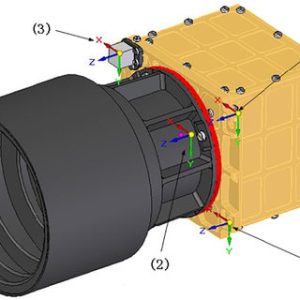Star sensors are critical components in satellite navigation and attitude control, providing precise orientation by detecting and analyzing star positions. However, star sensor failure can significantly impact satellite operations, leading to degraded performance or mission failure. Understanding the causes and solutions for star sensor failure is essential to ensure the reliability of space missions.

Common Causes of Star Sensor Failure
- Radiation Damage
Radiation exposure is one of the most common causes of star sensor failure in space. High-energy particles from the Sun and cosmic rays can degrade sensitive electronic components, reducing the sensor’s accuracy or rendering it non-functional. Prolonged exposure to radiation environments, especially in deep space, increases the risk of such failures.
- Thermal Stress
Satellites operate in extreme temperature conditions, from intense solar heat to the cold of shadowed space. Frequent temperature fluctuations can cause thermal stress, leading to mechanical deformation or electronic malfunctions within the star sensor. Over time, this may compromise its ability to detect stars accurately.
- Contamination of Optical Elements
The performance of star sensors heavily depends on their optical components, such as lenses and mirrors. Contamination from particles, outgassing, or debris can obscure these optical elements, reducing their sensitivity and leading to inaccurate readings or complete operational failure.
- Software Errors
Star sensors rely on advanced algorithms to process star patterns and determine orientation. Software bugs, outdated algorithms, or improper calibration can lead to incorrect data output, mimicking a hardware failure.
- Mechanical Vibrations and Launch Stress
The intense vibrations and stresses experienced during satellite launch can damage star sensors. Improperly secured components or flaws in the sensor design can result in misalignment or mechanical failure once the satellite is deployed.
- Obstruction of Star Visibility
Environmental factors, such as light from the Sun or Earth, can obstruct star visibility, leading to temporary or permanent star sensor failure. In low Earth orbit, atmospheric glow or reflection from satellite surfaces can interfere with the sensor’s ability to detect stars accurately.
Effects of Star Sensor Failure on Satellite Missions
Star sensor failure can have widespread consequences for satellite operations:
- Loss of Attitude Control
Without accurate star data, the satellite may lose its ability to maintain the correct orientation, affecting communication, imaging, and data collection capabilities.
- Increased Energy Consumption
Alternative methods of orientation control, such as gyroscopes or manual adjustments, require more power, reducing the satellite’s operational lifespan.
- Degraded Mission Performance
Scientific and Earth observation missions relying on precise orientation suffer from blurred imaging or inaccurate measurements, lowering the value of collected data.
Preventive Measures for Reducing Star Sensor Failure
- Radiation-Hardened Design
Using radiation-tolerant materials and shielding star sensors can mitigate damage from high-energy particles. Advanced designs incorporate radiation-resistant electronics to enhance durability in space.
- Thermal Control Systems
Efficient thermal control systems, such as insulation and radiators, protect star sensors from extreme temperature variations. Maintaining a stable operating environment reduces the risk of thermal stress.
- Improved Optical Shielding
Shielding optical components against contamination and glare improves star sensor reliability. Special coatings and protective covers help maintain lens clarity, ensuring consistent performance over time.
- Vibration Testing During Development
Comprehensive vibration testing of star sensors during the development phase ensures they can withstand the mechanical stresses of launch. This step identifies and addresses potential weaknesses in design and assembly.
- Software Redundancy
Incorporating error-correction algorithms and regular software updates ensures the accuracy of star sensor data. Autonomous recalibration systems can adjust settings to compensate for environmental changes.
- Enhanced Maintenance Protocols for Satellites in Low Earth Orbit
For satellites in low Earth orbit, designing systems to minimize atmospheric interference, such as positioning star sensors away from reflective surfaces, can enhance reliability.
Steps to Address Star Sensor Failure
- Automatic Backup Systems
Many satellites are equipped with redundant star sensors to ensure uninterrupted operation in case of primary sensor failure. Switching to backup systems allows satellites to continue functioning with minimal disruption.
- Real-Time Error Detection and Correction
Implementing real-time monitoring systems can detect anomalies in star sensor performance and initiate corrective measures. These systems ensure timely identification of failures before they escalate.
- Manual Intervention from Ground Control
When automatic systems are insufficient, ground control can step in to analyze the problem and make necessary adjustments. Remote software updates and recalibration may restore sensor functionality.
- Integration with Other Orientation Systems
Combining star sensors with gyroscopes or magnetometers provides additional orientation data, reducing reliance on a single system. This hybrid approach enhances resilience against individual component failures.
Future Innovations to Minimize Star Sensor Failure
Advancements in materials science, electronics, and software are driving the development of more robust star sensors:
- Miniaturization of Star Sensors
Smaller, lightweight designs reduce stress on components while maintaining functionality. These compact sensors are also more adaptable for use in CubeSats and small satellite constellations.
- AI-Enhanced Algorithms
Artificial intelligence is being integrated into star sensor algorithms to predict and mitigate failure scenarios. AI systems can adapt to changes in real time, enhancing operational reliability.
- Improved Radiation Shielding Materials
Research into advanced materials with superior radiation resistance promises longer operational lifespans for star sensors, particularly in deep-space missions.
By addressing the causes of star sensor failure and implementing effective preventive measures, mission planners can significantly enhance satellite reliability. These improvements ensure successful navigation, precise orientation, and the long-term success of satellite missions.
